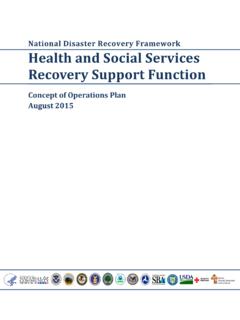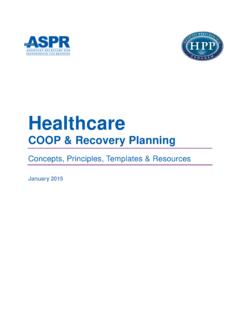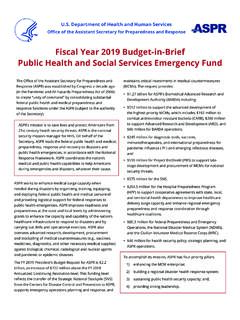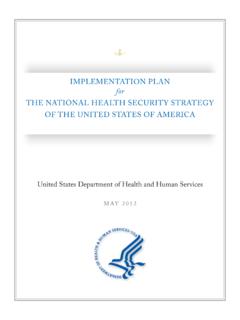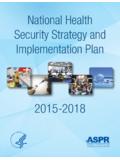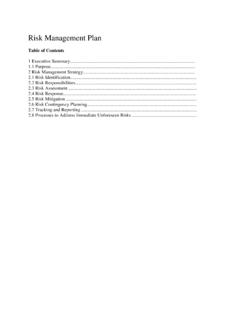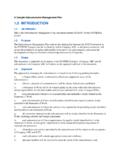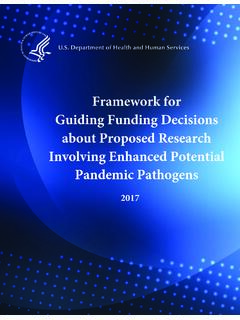Transcription of Don R. Boyce
1 1 Incorporating Active Shooter Incident planning Into Health Care Facility Emergency Operations Plans Incorporating Active Shooter Incident planning into Health Care Facility Emergency Operations Plans Department of Health and Human Services Department of Homeland Security Department of Justice Federal Bureau of Investigation Federal Emergency Management Agency 2014 Incorporating Active Shooter Incident planning Into Health Care Facility Emergency Operations Plans This report was prepared by staff from the Department of Health and Human Services, Office of the Assistant Secretary for Preparedness and Response, Division of Health System Policy, and Division of Tactical Programs , in collaboration with staff from the Federal Emergency Management Agency and the Federal Bureau of Investigation.
2 Additional comments were received from staff at the Department of Education and from the Healthcare and Public Health Sector Coordinating Council. The views expressed herein represent the collective expertise of the federal agencies issuing this document. This publication contains information about and from outside organizations, including hyperlinks and URLs, although inclusion of such information does not constitute an endorsement by the Department. Department of Health and Human Services Sylvia M. Burwell Secretary Office of the Assistant Secretary for Preparedness and Response Nicole Lurie Assistant Secretary Office of Emergency Management Don R. Boyce Director Office of Policy and planning Lisa G.
3 Kaplowitz Director November 2014 This report is a government product. While permission to reprint this publication within the United States is not necessary, the suggested citation is: Department of Health and Human Services, Office of the Assistant Secretary for Preparedness and Response, Incorporating Active Shooter Incident planning into Health Care Facility Emergency Operations Plans, Washington, DC, 2014. Works cited to in this report may be protected by copyright. To obtain copies of this report: Download online from the Off ice of the Assistant Secretary for Preparedness and Response at or at the Federal Emergency Management Agency at 2 Incorporating Active Shooter Incident planning Into Health Care Facility Emergency Operations Plans Table of Contents Introduction.
4 5 Background .. Complex, Multifaceted 7 Operational Demands .. 7 Potential Targets .. 8 Highly Varied and Widely Vulnerabilities ..8 Workforce ..8 Resource Constraints ..9 Dynamic ..9 Active Shooter Incidents ..9 planning for an Active Shooter Incident ..10 Who is the Active Shooter? ..14 Threat Assessment Team ..16 Response: Practical Application of the Run, Hide, Fight Model in an HCF ..19 Hide .. 20 Fight .. 21 Interacting with First Exercises and Training ..22 After an Active Shooter Incident ..23 Psychological First Aid ..25 Training on Psychological First Aid .. 27 Appendix A: Information Sharing ..1 Health Insurance Portability and Accountability Act of Is HIPAA? .. 1 How Does HIPAA Apply in HCF s? ..2 HIPAA Guidance and R esources .. 3 3 Incorporating Active Shooter Incident planning Into Health Care Facility Emergency Operations Plans Appendix B: Security.
5 14 Incorporating Active Shooter Incident planning Into Health Care Facility Emergency Operations Plans Introduction Our Nation s health care facilities (HCFs) are entrusted with providing expert medical care in safe and secure environments for patients, staff, and visitors. HCFs include hospitals, health clinics, hospices, long-term care facilities, academic medical centers, group medical care facilities, and physicians and other health care providers offices. HCFs are faced with planning for emergencies of all kinds, ranging from active shooters, hostage situations, and other similar security challenges, as well as threats from fires, tornadoes, floods, hurricanes, earthquakes, and pandemics of infectious diseases.
6 Many of these emergencies occur with little to no warning; therefore, it is critical for HCFs to plan in advance to help ensure the safety, security, and general welfare of all members of the health care community. This document is primarily designed to encourage facilities to consider how to better prepare for an active shooter1 incident. Though hospitals and many other HCFs have emergency operations plans (EOPs), this document provides emergency planners, disaster committees, executive leadership, and others involved in emergency operations planning with detailed discussions of unique issues faced in an HCF. This document also includes discussions on related topics, including information sharing, psychological first aid (PFA), and law enforcement/security. EOPs for HCFs should be living documents that are routinely reviewed and consider all types of hazards, including the possibility of an active shooter or terrorist incident.
7 As law enforcement continues to draw lessons learned from actual emergencies, HCFs should incorporate those lessons learned into existing EOPs or in newly created EOPs. A whole community approach to HCFs includes staff, patients, and visitors. Likewise, the whole HCF community includes individuals with access and functional needs. Examples of these populations include children, older adults, pregnant women, individuals with disabilities, individuals who live in institutional settings, individuals from diverse cultures, individuals who have limited English proficiency or are non-English speaking, individuals who are transportation disadvantaged, individuals experiencing homelessness, individuals who have chronic medical conditions, and individuals who have pharmacological dependency.
8 Background National preparedness efforts, including planning , are based on Presidential Policy Directive (PPD) 8: National Preparedness, which was signed by the President in March 2011. This directive represents an evolution in our collective understanding of national preparedness based on lessons learned from natural disasters, terrorist acts, and active shooter and other violent incidents. PPD-8 defines preparedness around five mission areas: Prevention, Protection, Mitigation, Response, and recovery . These concepts are also applicable to HCF planning for an active shooter incident or other event, and the below definitions have been modified from PPD-8 for the purposes of this guide: 1 Active shooter incidents are defined as those where an individual is actively engaged in killing or attempting to kill people in a confined and populated area.
9 Active Shooter: How to Respond. Department of Homeland Security. 2013. espond 5 Incorporating Active Shooter Incident planning Into Health Care Facility Emergency Operations Plans Prevention, 2 for the purposes of this guide, means the capabilities necessary to avoid, deter, or stop an imminent threat. Prevention is the action HCFs take to keep a threatened or actual incident from occurring. Protection means the capabilities to secure HCFs against acts of terrorism and man-made or natural disasters.
10 Protection focuses on ongoing actions that protect patients, staff, visitors, networks, and property from a threat or hazard. Mitigation means the capabilities necessary to eliminate or reduce the loss of life and property damage by lessening the impact of an event or emergency. In this document, mitigation also means reducing the likelihood that threats and hazards will happen. Response means the capabilities necessary to stabilize an emergency once it has already happened; restore and establish a safe and secure environment; save lives and prevent the destruction of property; and facilitate the transition to recovery . recovery means the capabilities necessary to assist HCFs affected by an event or emergency in restoring the treatment/therapeutic environment as soon as possible.
